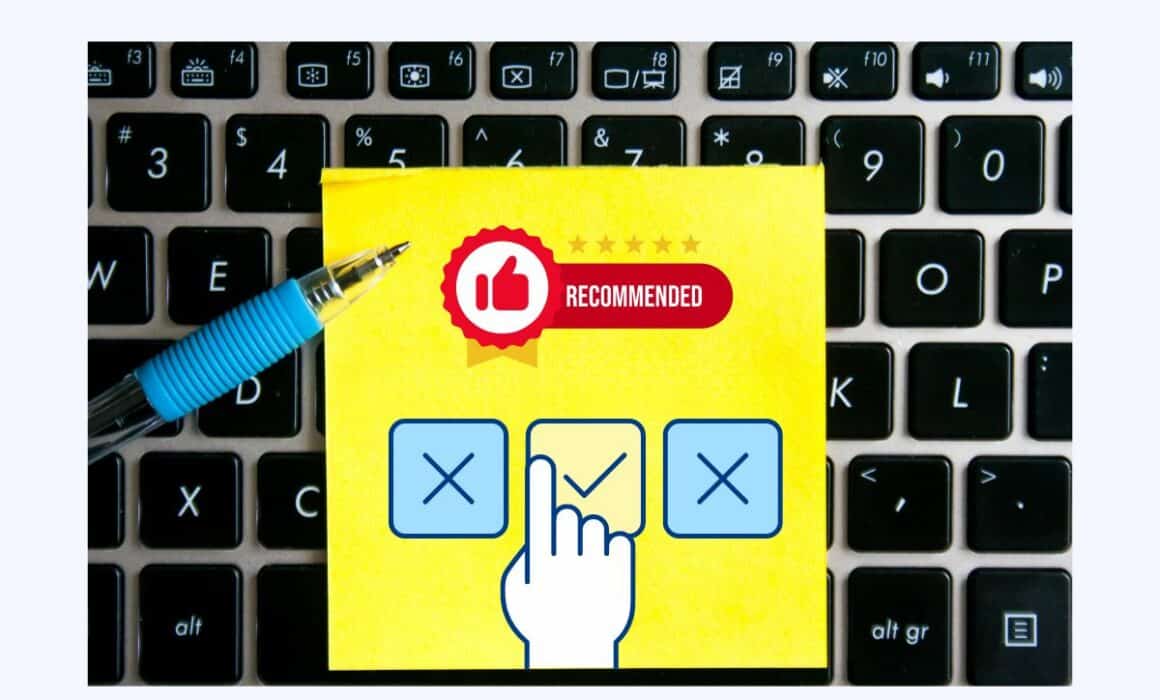Product Management Framework: 24 Best Options To Use In 2023
A product management framework is a pivotal asset within a product manager’s toolkit. They’re responsible for building successful and profitable products addressing customer pain points. Because of this, they’ll need to be methodical with how they approach their workflows. Thankfully, several product management frameworks are available today to assist product managers in this effort.
We understand that employing the right product management framework is critical to consistently creating products that sell and provide value. Because of this, our team at Mambo.io compiled some of the best product management framework options you can use in 2023. Below are some essential product management frameworks to help you develop successful products and make better decisions.
Table of Contents
Product management framework options for prioritization
#1. RICE framework
The RICE framework is a tool that helps teams decide which projects or features to prioritize based on their impact. It originated at Intercom to help product managers make better decisions and solve some problems they face. Each factor this framework uses is assigned a numerical value to calculate a prioritization score for different projects or initiatives.

This framework lets you assign a numerical value to features or initiatives based on reach, impact, confidence, and effort. Afterwards, they can use these values to generate a so-called RICE score using a formula.
When to use the RICE framework
This is one of the best product management frameworks for prioritization and resource allocation. Additionally, it comes in handy when measuring and comparing the value and costs of various products and features.
#2. Kano model
The Kano model can help identify customer preferences by categorising them into Must-Haves, Performance Features, and Delighters. The product team can use this framework to assess each initiative based on two main factors. First is their potential to delight customers, and second is the implementation costs of each of them. Ultimately, the priority should be the features that are highly delightful and cheap.
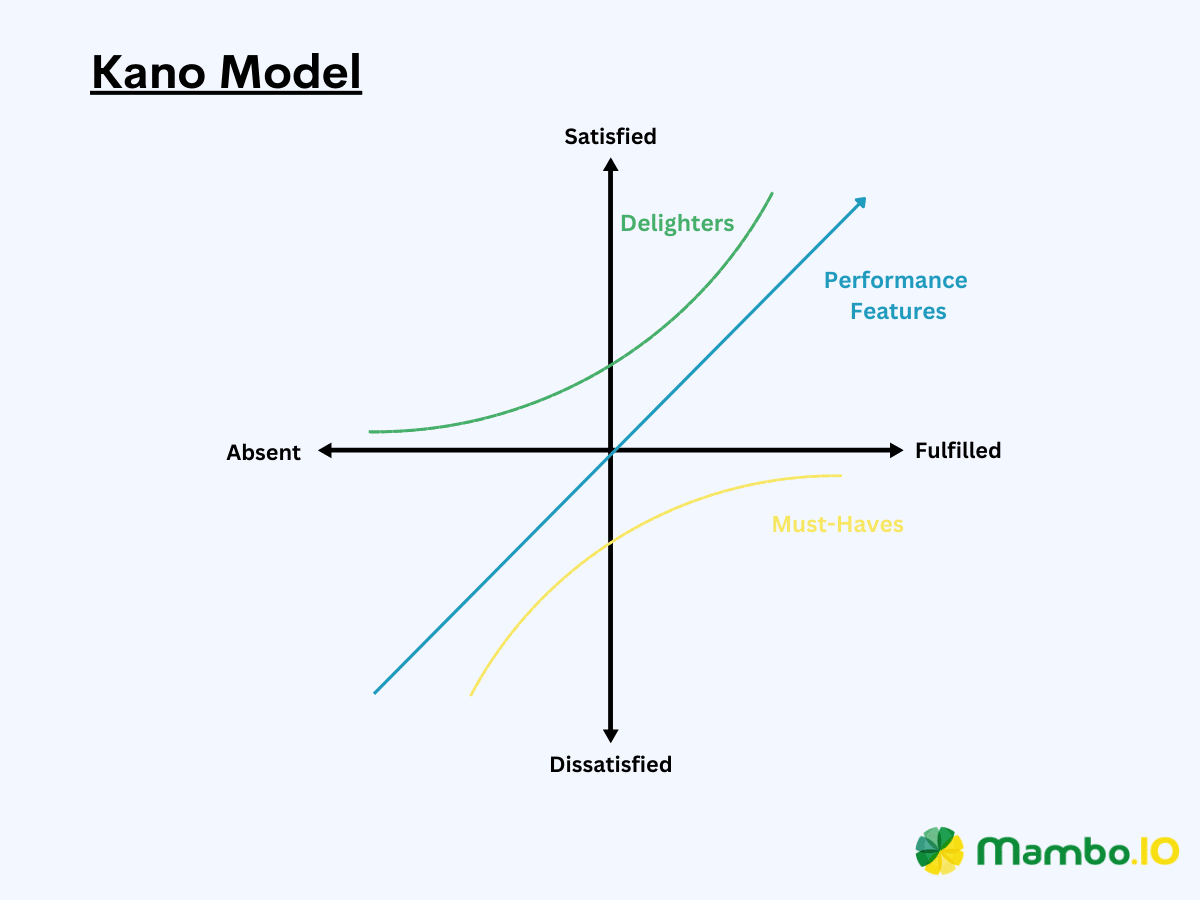
Since it revolves around customer feedback and satisfaction, this framework can identify the most valuable features for your users.
When to use the Kano model
You can use the Kano model to prioritize features and initiatives effectively by determining customer preferences and categorising feature importance.
#3. MoSCoW method
The MoSCow method is a prioritization framework that categorizes initiatives according to their importance and feasibility. By doing so, product managers can address the initiatives’ essential elements while accommodating potential tradeoffs. More importantly, this framework can make communicating the importance of each initiative to the stakeholders much easier.
While the name may sound quirky, it’s a clever acronym for Must-Haves, Should-Haves, Could-Haves, and Won’t-Haves. These terms are the category buckets that help teams strategise and build their roadmaps accordingly.
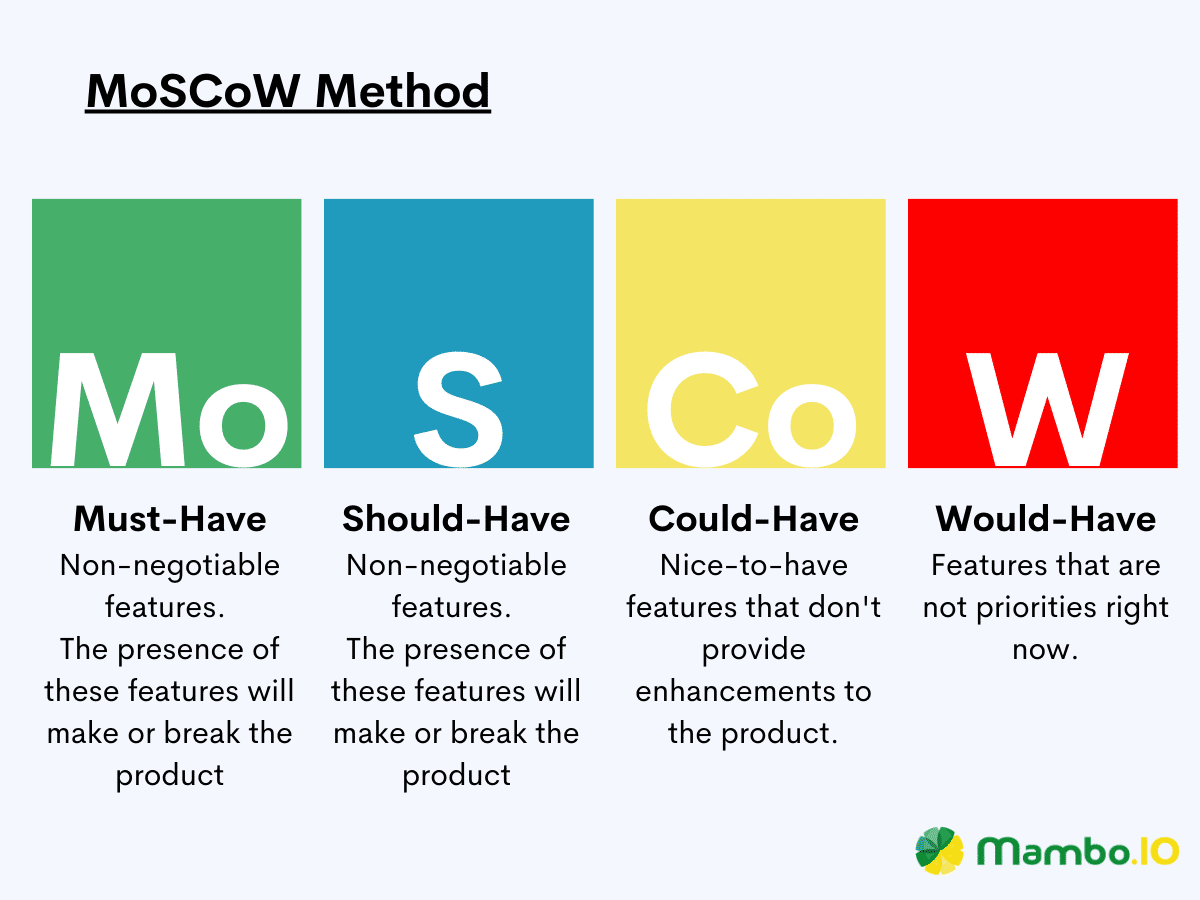
When to use the MoSCoW method
This prioritization framework lets everyone involved in a project know what work to complete first. These priorities help increase revenue, decrease operational costs, improve productivity, and boost customer satisfaction. Therefore, you can use the MoSCoW method if you want to involve the stakeholders in your operational structure. It also proves valuable for assessing the effort required for each category.
#4. Story mapping
Story mapping is a visual technique that helps product managers prioritize and organise user stories. This framework can be instrumental in building a cohesive product roadmap and allows teams to understand their customer’s user journey better.
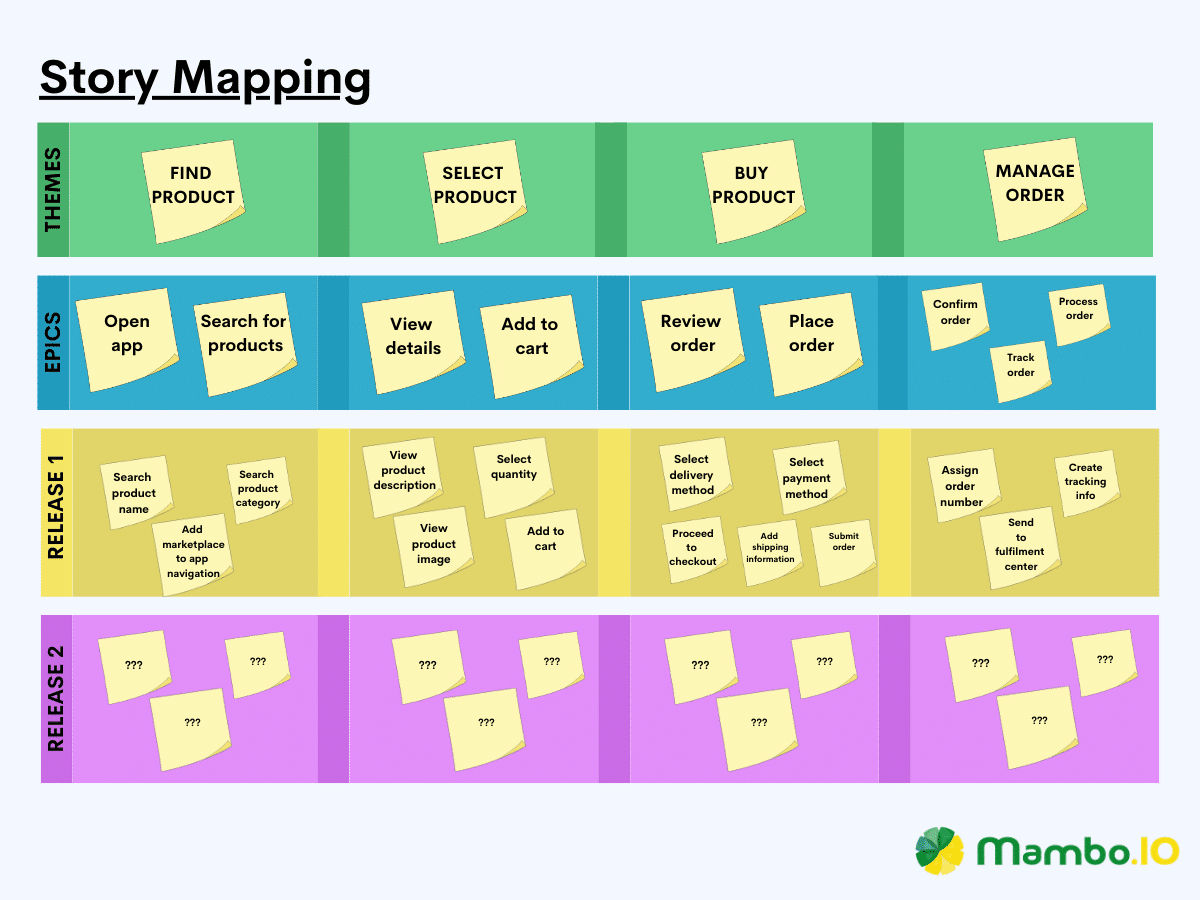
This practical tool places users at the heart of the development process. Through this approach, you can visually represent the user journey, highlighting each step they take. Ultimately, you can minimise the friction they experience while using your app with this effective product management framework.
When to use story mapping
When starting a new project, product managers can use story mapping to establish a clear roadmap of features and user interactions. Moreover, it’s also useful for feature prioritization focusing on user experience.
#5. North Star framework
The North Star framework is a strategic tool product managers use to define their “north star”. This guiding star represents a high-level metric that is the primary compass directing the entire product team. Moreover, it embodies the ultimate goal or outcome the product strives to realise for its users. This is one of the best product management frameworks that best captures the core values your product delivers to its customers.
Here are the north star metrics of some of the most prominent companies today.
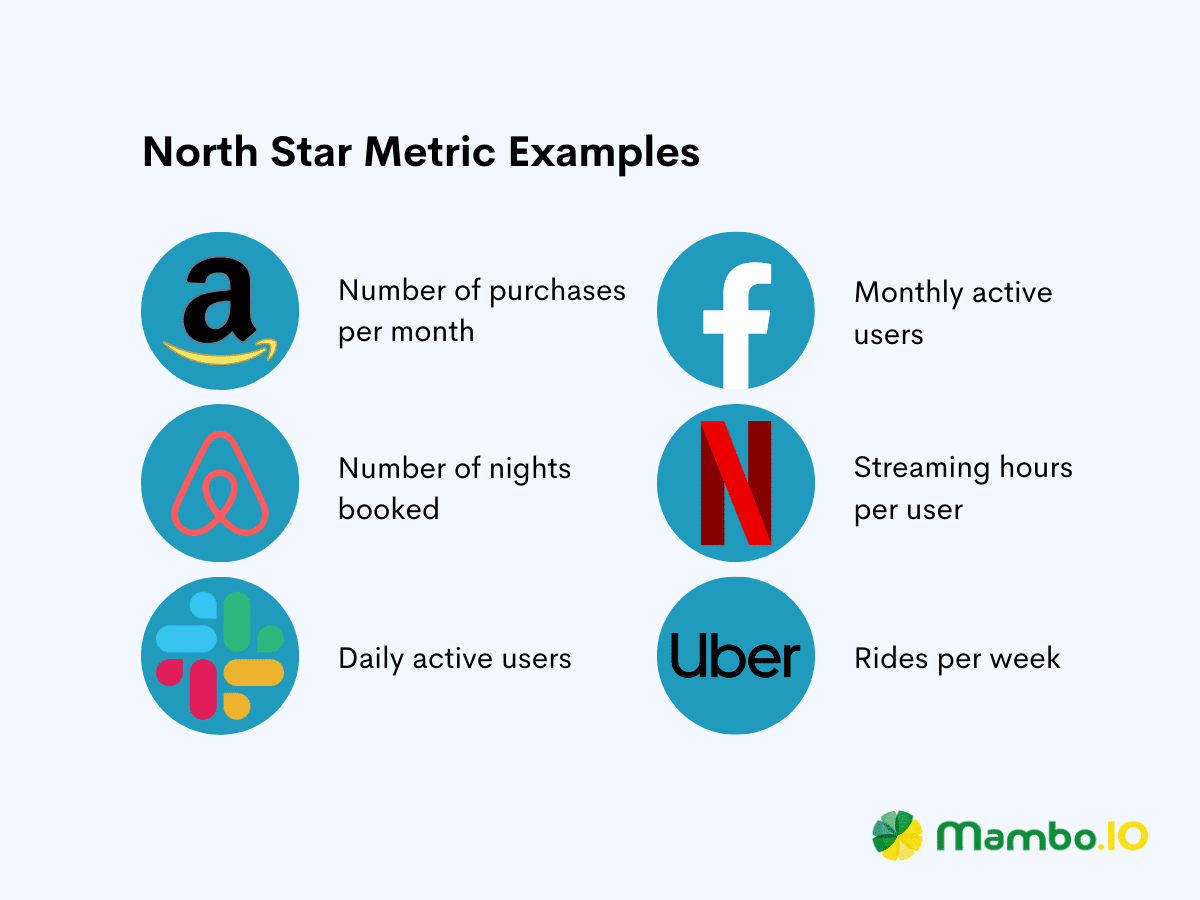
An excellent North Star that is worth following has the following qualities:
- Clearly articulates the value it offers
- Can present both past achievements and future forecasts
- Leaves behind a trail of actionable steps that the team can follow.
- Easily understandable, even for non-technical people
- Is measurable
When to use the North Star Framework
You can use this framework to establish a clear, overarching goal to guide your team’s efforts and decisions. Some situations where the framework’s usefulness arises include strategic alignment, new product or feature launch, and prioritization.
#6. Weighted impact scoring
It’s common for top product managers to use the Weighted Impact Scoring because of its effectiveness. This is possible because it scores features, product ideas, and initiatives based on their impact and significance.
You’ll start by assigning weights to different criteria, then score each item to calculate their overall weighted score. Then, you can rank each of these items accordingly. The higher their overall weighted scores are, the better candidate they are for prioritization. Below is an excellent example of how a company uses the Weighted Impact Scoring for their product development process.

When to use the weighted impact scoring
This framework comes in handy when product managers need to make data-driven decisions involving prioritization, resource allocation, and strategic planning. You can also use this product management framework to make complex decisions and choose initiatives with the highest ROIs.
Product management framework options for design thinking
#7. Design sprints
Design sprints are time-bound workshops created by Google Ventures that aim to solve design problems quickly. It gained traction for its effectiveness in generating creative solutions and validating ideas quickly. They typically take five steps or five days, aiming to bring together cross-functional teams to ideate, prototype, and validate solutions. Ultimately, its objective is to reduce the risks of launching a product.
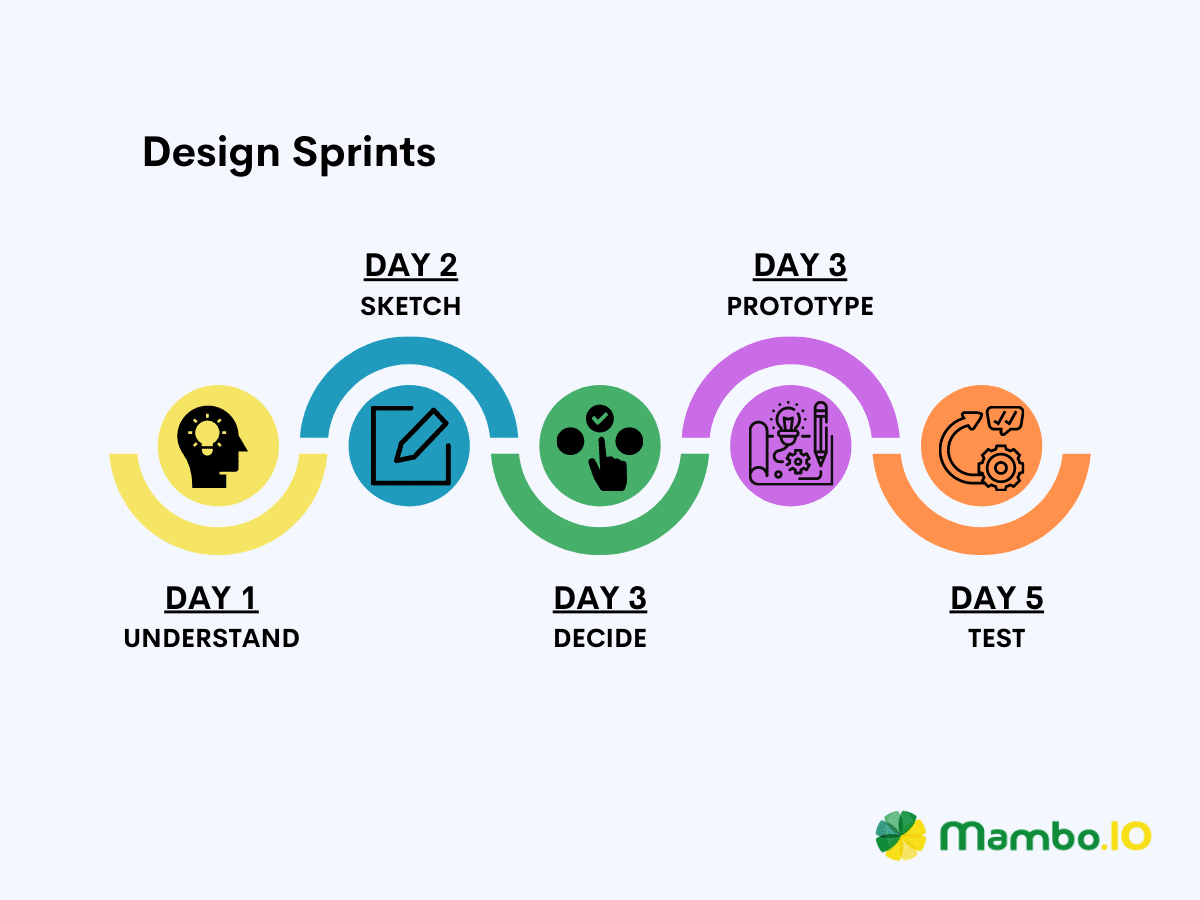
This framework draws inspiration from design thinking, a high-level framework that encourages product managers to do the following:
- Empathise
- Define
- Ideate
- Prototype
- Test
- Implement
When to use design sprints
Tackling complex problems that require fresh perspectives and innovative solutions can be much easier with Design Sprints. Product managers can also use this framework to quickly validate a concept or idea before investing significant resources.
#8. Customer journey map
With the help of the Customer Journey Map, product managers can visualise users’ end-to-end experience with a product. This framework offers a visual representation covering the user’s pleasure and pain points. More importantly, it helps organisations identify viable opportunities to improve their product’s user experience. Doing so can increase the chances of turning potential users into repeat customers.
Here’s what you need to create a winning customer journey map:
- Buyer personas
- Map of your customer’s pain points and pleasure points
- An optimised user experience
KPIs and metrics to measure the framework’s success

The main goal of this framework is to help the entire organisation empathise with their users. The company can create a satisfying product if everyone understands customers’ wants and needs.
When to use the Customer journey map
This framework is precious during the initial research stage during the development of a new product. It can also guide product managers when navigating shifts whenever the product is undergoing changes or adjustments.
#9. HEART framework
Google developed the HEART framework to quantify and improve user experience (UX). It is a framework that empowers any product team to assess the UX of their products and gain insight into user satisfaction.
The HEART framework breaks down into five key metrics:
- Happiness. This metric gauges user satisfaction and sentiment.
- Engagement. Measures the level of user involvement and interaction with the product.
- Adoption. Focuses on how quickly users embrace the product.
- Retention. Reflects how well the product retains its user base over time.
- Task Success. Evaluates how effectively users can achieve their intended tasks within the product.

These metrics collectively provide a comprehensive understanding of the user’s interaction and satisfaction with your product.
When to use the HEART framework
The HEART framework applies to situations where product managers must evaluate conflicting projects and identify the most important ones. It can be helpful for UX improvements, new feature rollouts, and monitoring long-term product success.
#10. The double diamond design process
If you want to simplify problem-solving and innovation, consider using the Double-diamond design process model. It is a structured approach made by the British Design Council that involves four phases:
- Discover. Understanding the problem space and gathering insights.
- Define. Synthesizing the information gathered to define problem statements and user personas clearly.
- Develop. Generating and iterating on potential solutions.
- Deliver. Transitioning from idea development to execution.

This template allows product managers to understand their user’s needs deeply, ideate creative solutions, and execute initiatives efficiently. The updated version of the Double Diamond framework lets teams jump around each part of the product development process. This is far better than the original approach, where they can only work linearly.
When to use the double diamond design process
Use the Double Diamond design process to start new product development processes. You can also utilise it when you need to enhance existing features on a product.
#11. CIRCLES method
The CIRCLES method is a framework designed to provide a thoughtful yet critical response to product design questions. This framework is designed by the product management expert Lewis C. Lin and is featured in his book Decode and Conquer. It is usually used by professionals who want to ace product manager interviews and enter prestigious companies like the MAANG.
The term CIRCLES stands for:
- Clarify the situation (who, what, where, when, why, how?).
- Identify the customer (through user personas).
- Report the customer’s needs (what value the customer wants to get from your product).
- Cut through prioritization (identify priorities).
- List solutions (create possible solutions to the design problem).
- Evaluate tradeoffs (determine the underlying tradeoffs for each solution).
- Summarise recommendations (compile all final recommendations).
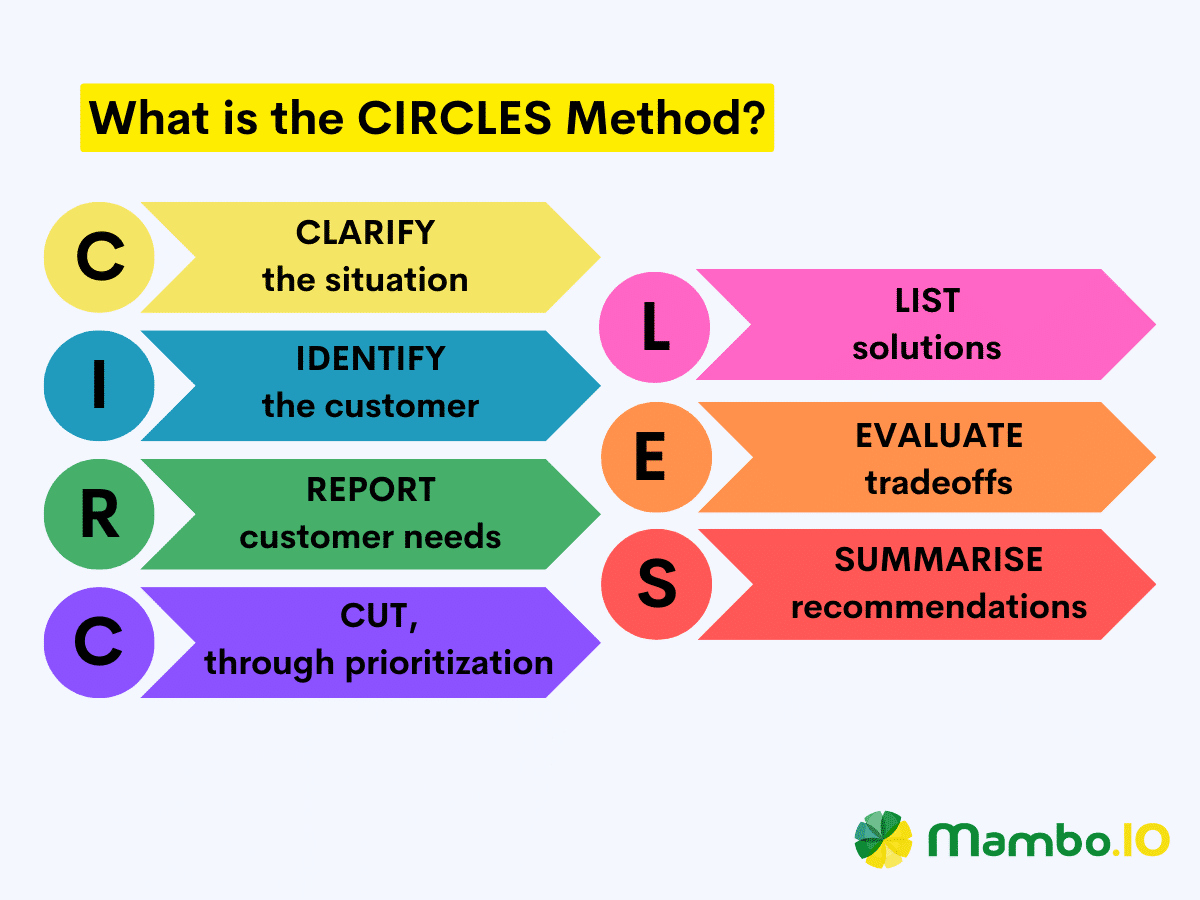
When to use the CIRCLES method
The CIRCLES method proves to be extremely useful for product manager interview preparations. However, it can also be used as a guide when formulating product strategies and roadmaps.
Product management framework options for discovery
#12. Jobs to Be Done (JTBD)
The Jobs to be Done framework revolves around identifying your customer’s needs. But instead of using personas, this framework utilises scenarios, redirecting the focus from the product to the customers. It highlights the fundamental reasons users “hire” a product to fulfil a particular task. Ultimately, this framework enables product managers to design products that address real user needs and create meaningful solutions.
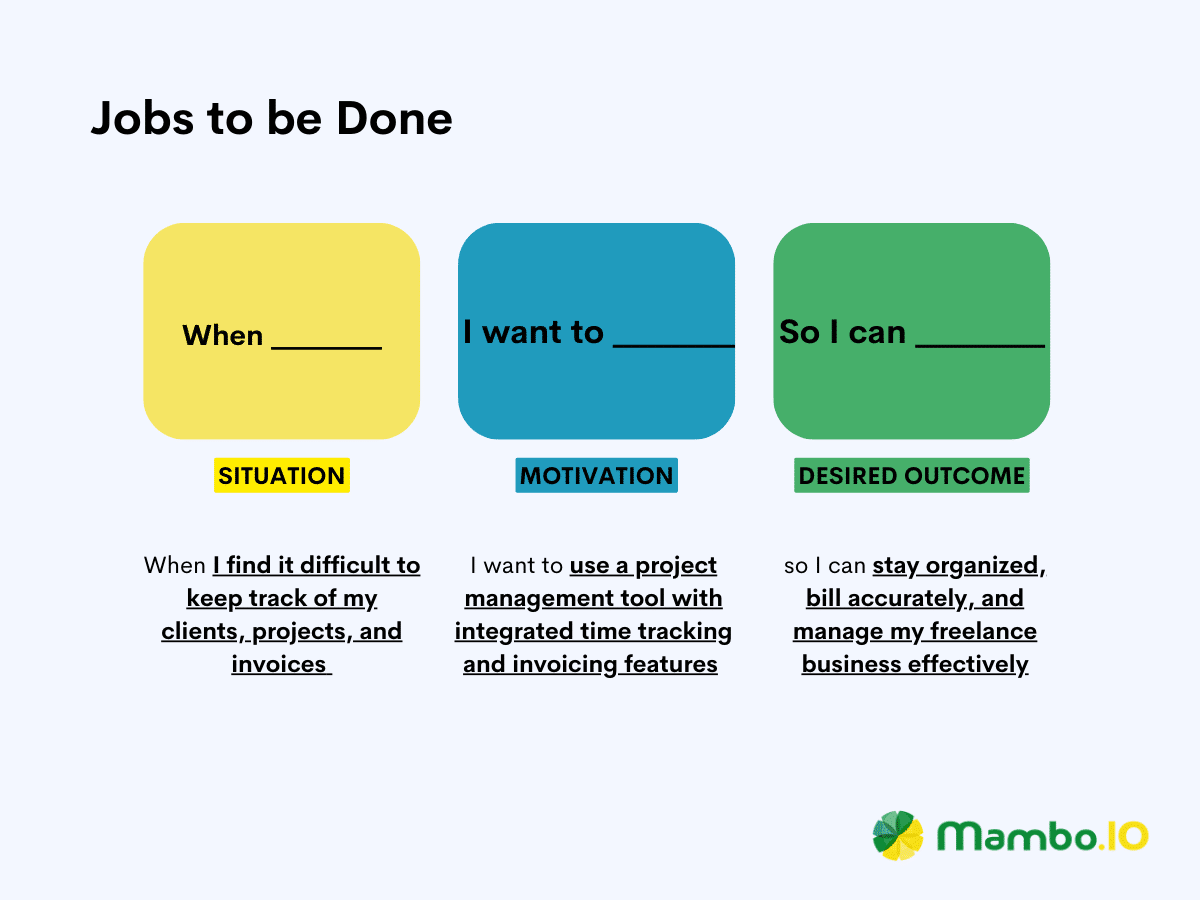
When to use the Jobs to be Done (JBTD)
You can use this framework to uncover why your customers seek solutions by “hiring” products. Some tasks that involve this framework include market research, product definition, feature prioritization, and more.
#13. Working backward (the Amazon method)
The Working Backward framework is one of the reasons why Amazon became the e-commerce titan it is today. Commonly referred to as the Amazon method, this framework reverse-engineers the product development process.
How?
By defining the end goal of the product development process first and then working backwards to create a product strategy.
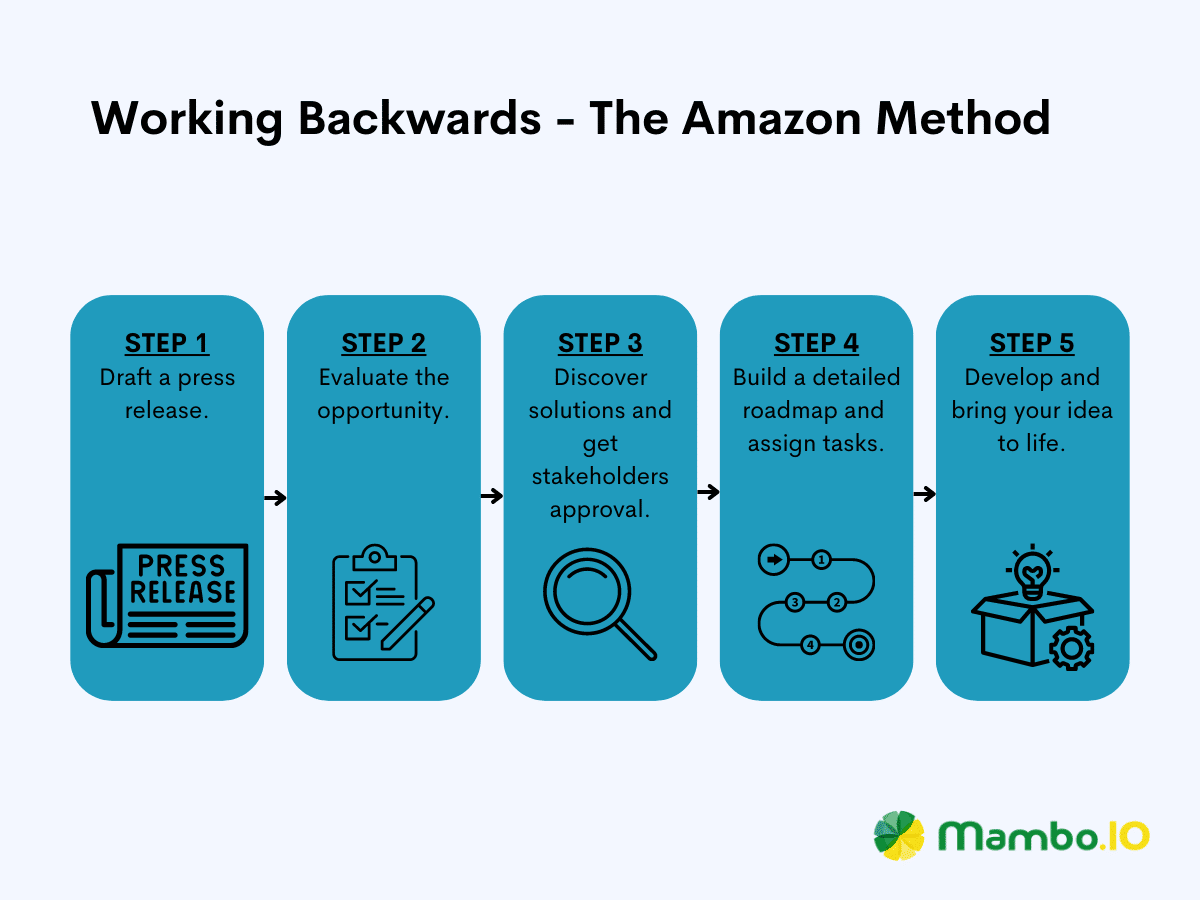
When to use the working backwards (Amazon method)
Product managers should consider using “working backwards” when they want to develop a clear and customer-focused product strategy. Some instances where this framework works include defining product visions and launching a new product, to name a few.
#14. Spotify model
Spotify, the most prominent digital music service provider today, can teach us a thing or two about effective product management. One standout approach they’ve pioneered is the Spotify model, often called Spotify squads. It involves utilising autonomous squads with the freedom to focus on projects that align closely with their expertise.
The core concept of the Spotify model revolves around delivering exceptional products while minimising risks and operational expenses. But despite their independence, these squads maintain a high level of alignment, ensuring these expectations are met. This is one of the reasons why Spotify’s scaling agile methodology proved to be a huge success.
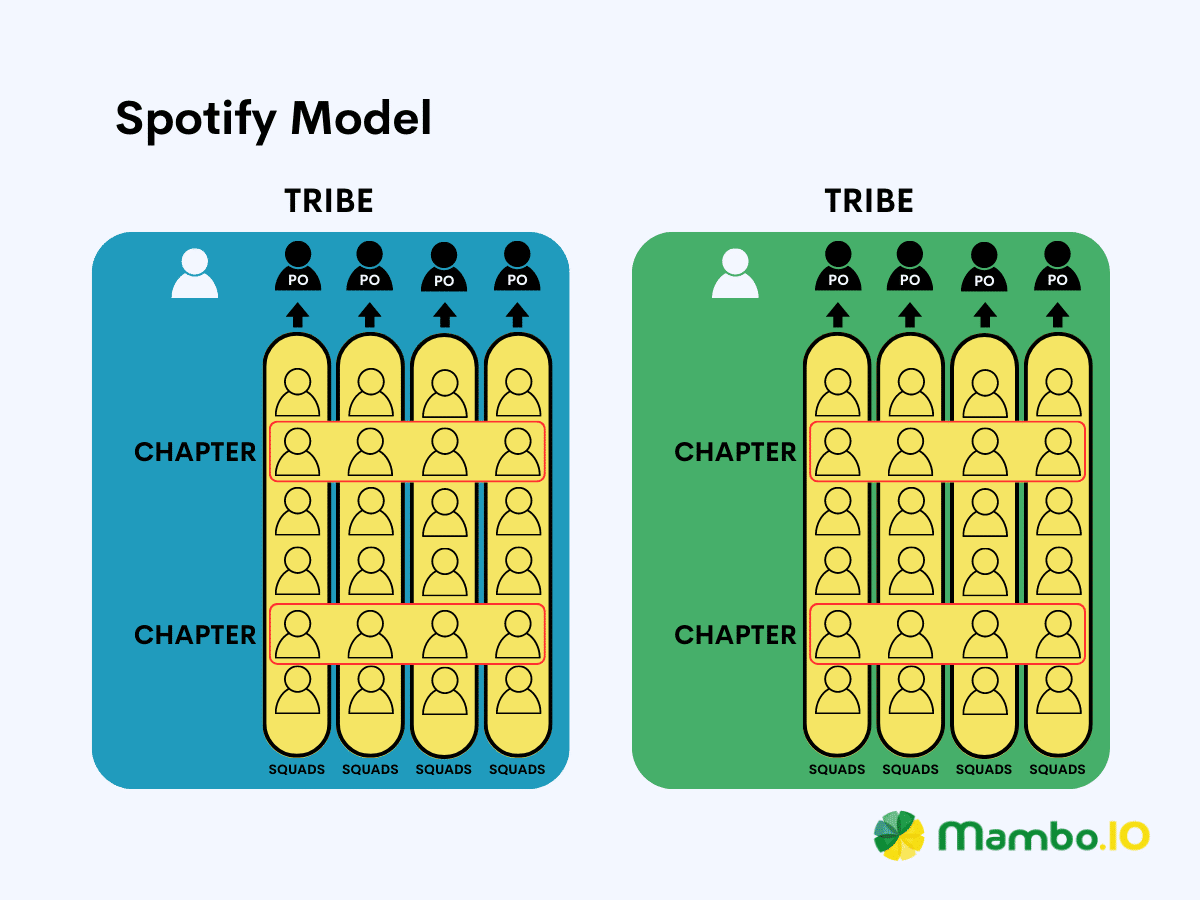
This framework follows the model below to deliver quality products and features:
- Think it. This initial stage involves teams researching product ideas, validating problems, and experimenting with potential solutions.
- Build it. In the second stage, teams develop and test their minimum viable product (MVP).
- Ship it. Following development, the feature is released to the public. Initially, a selected user group gains access to the feature for testing purposes. Upon its success, the feature is rolled out to the entire user base.
- Tweak it. Teams will work on necessary refinements to enhance the product or feature performance over time.
When to use the Spotify model
You can use the Spotify model to enhance collaboration, agility, and innovation within your product development team. Remember that this model is inherently tricky and may not be suitable for some organisations.
#15. Opportunity Solution Tree
Visual frameworks like the Opportunity Solution Tree can help your team makes conclusive solutions when solving product management problems. This framework involves breaking down a desired outcome into smaller and actionable opportunities. Your team can then analyse and leverage these opportunities until they reach a conclusive solution.
Breaking down desired outcomes into opportunities can be a complex endeavour. It’s one of the reasons why many product managers often turn to pre-designed templates to streamline their tasks. One of the best Opportunity Solution Tree templates we can recommend is the one offered by Miro. With this template, you can monitor the experiments that will pave the way toward your goals.
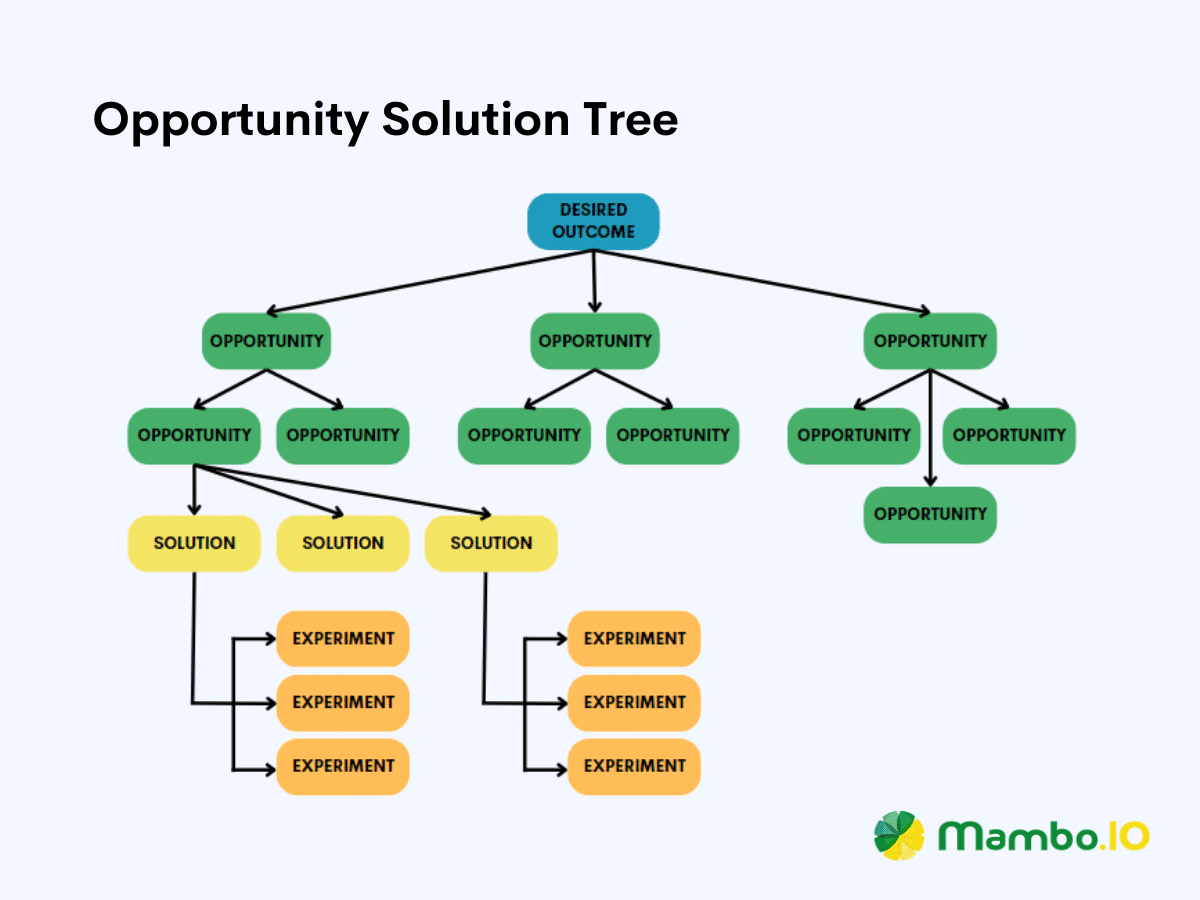
When to use the Opportunity Solution Tree
This product management framework is handy for making ideation and prioritization much more manageable. Additionally, it can help you avoid getting stuck in the discovery phase by letting you retrace your steps whenever needed.
Agile product management framework options
#16. Crystal agile framework
Crystal is an agile framework centred around people, prioritizing teams over tools and processes. If you’re familiar with the Agile Manifesto, you’ll recognize that this framework directly extends one of its fundamental principles.
The Crystal agile framework operates on the following philosophies:
- Teams can discover and refine their methods for enhancing and streamlining their workflow.
- Given the distinct nature of each product, product teams are responsible for determining the optimal approach for addressing their specific tasks.
When to use the Crystal Agile framework
Use the Crystal Agile framework if you want an agile methodology that can adapt to different needs, characteristics, and constraints. This framework comes in handy when products have resource limitations and variable requirements. Additionally, it works best when collaborating and communicating with small product teams.
#17. Disciplined Agile
The Disciplined Agile framework is another people-centric agile methodology that empowers teams to embrace the best workflow for them. But unlike the Crystal, it combines diverse methodologies such as Kanban and Scrum to forge a hybrid approach. The toolkit offered by this framework provides a range of options for tailoring processes to suit your organisation’s specific needs.
Check out the video below to learn more about what the Disciplined Agile framework is all about.
When to use Disciplined Agile
This is recommended for seasoned agile teams searching for a comprehensive and adaptable approach to steer their product development journey. It’s beneficial for scenarios where complex environments, regulated industries, and enterprise-level alignments are involved.
#18. Dual-Track Agile
The Dual-Track Agile is an agile framework centred around the idea that product development should be iterative and cyclical, not linear. It is a framework that divides the daily development work of product teams into two tracks: discovery and delivery. Discovery focuses on quickly generating validated products, while delivery centres on turning those ideas into market-ready products.
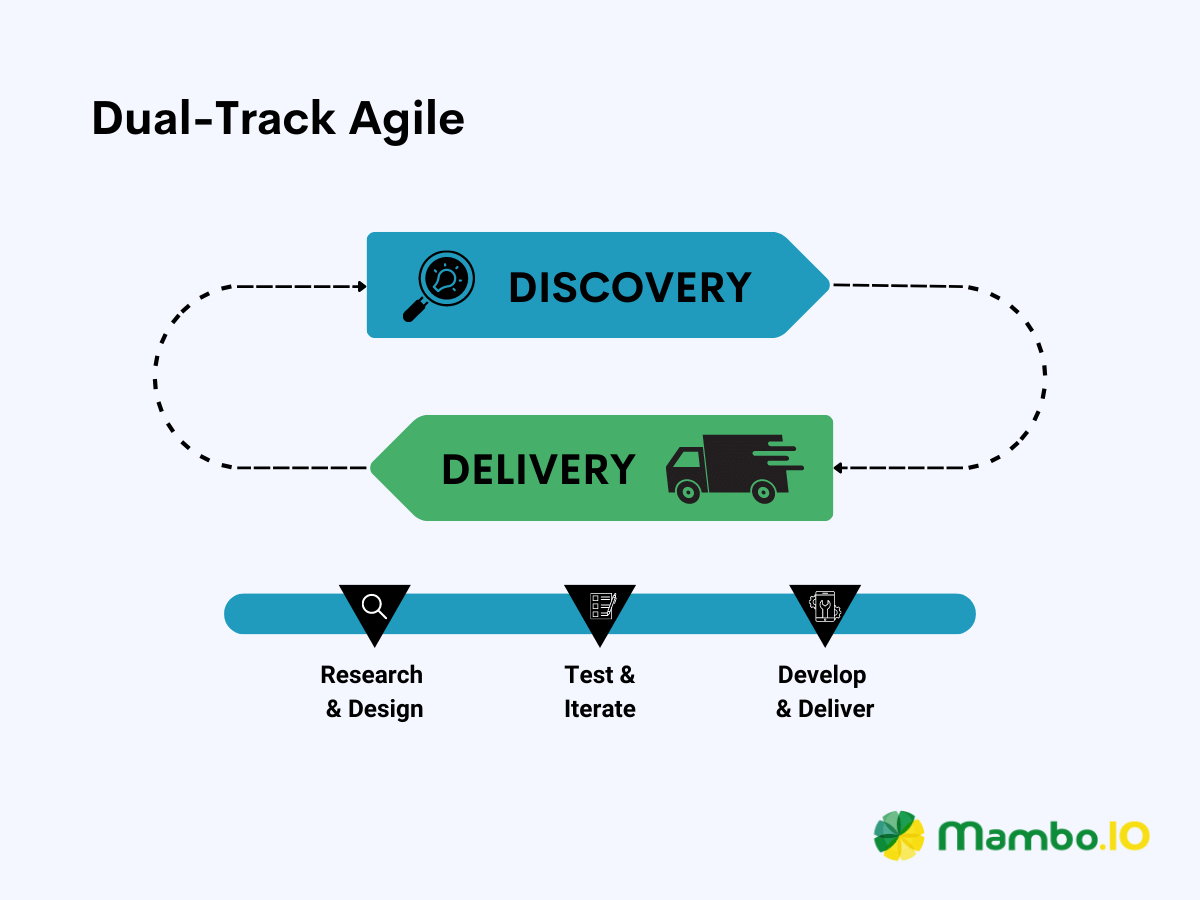
Product managers typically use this framework to ensure a balance between exploring new ideas and executing established features. By doing so, they foster innovation amongst the cross-functional teams involved while simultaneously maintaining a stable product.
When to use the Dual-Track Agile
The Dual-Track Agile is ideal when dealing with complex projects or uncertain market conditions. This approach can help you balance understanding user needs and delivering the features they want and need.
Strategy frameworks
#19. AARRR Framework
The AARRR framework (Pirate metrics) is a guiding model for product managers when gathering customer feedback post-launch. It is a framework that allows them to focus on the critical stages of the customer journey and monitor user behaviour. This enables them to track and optimise each stage’s metrics to drive growth and user engagement.
This framework outlines five essential stages in assessing a product’s success acquisition, activation, retention, revenue, and referral.
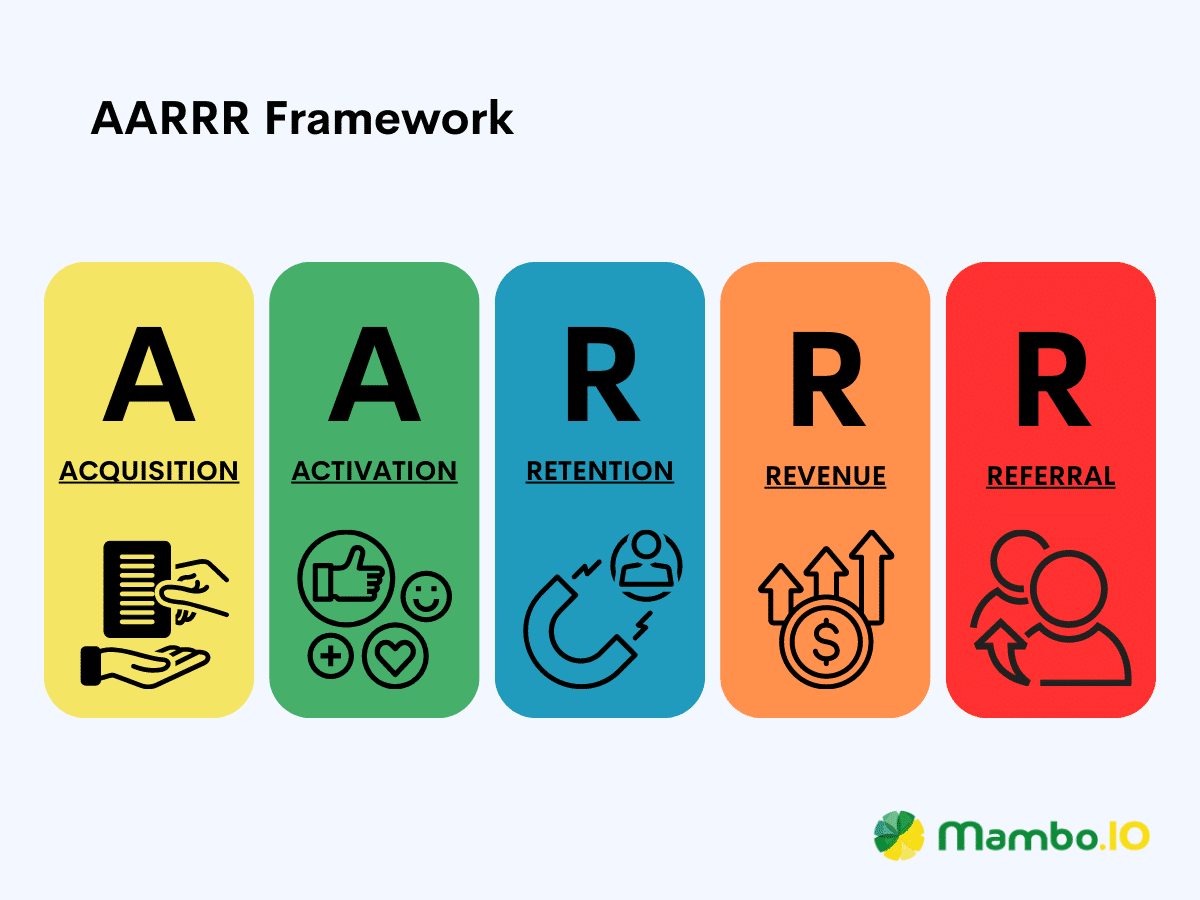
When to use the AARRR framework
Thanks to its remarkable versatility, the AARRR framework is indispensable for steering your product decision-making process. Additionally, you can utilise it to optimise the various stages of your product’s customer lifecycle. This framework applies to product launches, feature adoption, iterative product development, and more.
#20. GIST Planning
The GIST Planning framework simplifies how product managers connect their goals with practical tasks. It’s a refreshingly straightforward approach often chosen as an alternative to traditional product roadmaps.
At its core, GIST planning focuses on achieving goals instead of solutions. These goals set the compass for the team’s strategy, and every subsequent move can be linked back to these goals. It’s like following a trail of breadcrumbs, ensuring every action has its purpose.
The acronym GIST stands for the following:
- Goals. What objectives are you planning to accomplish?
- Ideas. What ideas are you considering to accomplish these objectives?
- Steps. What are the steps or phases needed to be set?
- Tasks. What are the specific tasks needed to accomplish your goals?
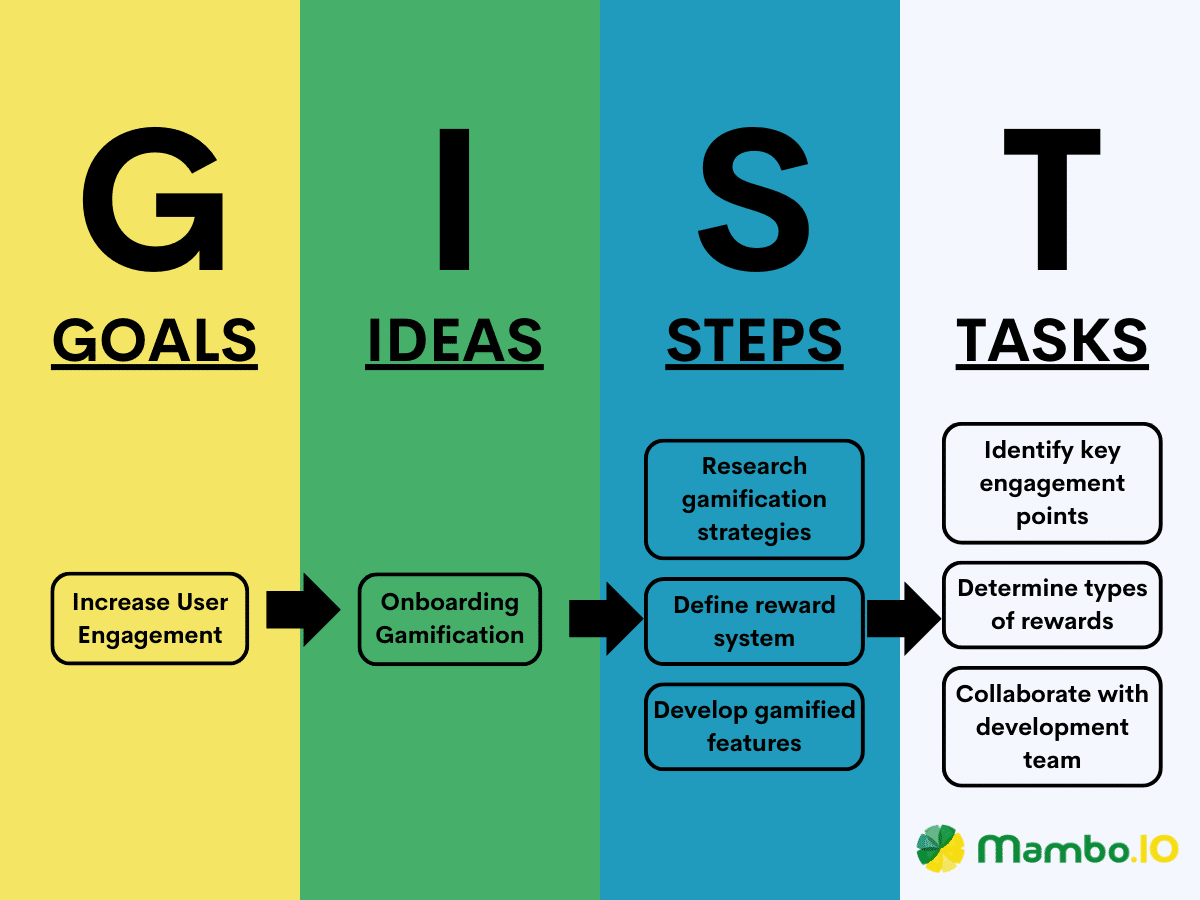
When to use GIST planning
GIST Planning is particularly useful for complex projects that involve multiple stakeholders and intricate requirements. Additionally, you can use this framework if you’re looking to reduce overhead management and improve your teams’ autonomy.
#21. Product Strategy Canvas
The Product Strategy Canvas is a visual tool many product managers use to craft a comprehensive and coherent product strategy. This canvas provides a structured framework for capturing and organising critical elements of a product’s strategy in a single view. In this perspective, product teams can determine their first objectives related to their vision and challenge.
Melissa Perri, the product consultant behind this framework, claims that a robust product strategy has the following elements:
- Vision. The vision articulates the ultimate destination or long-term aspiration that the product aims to achieve.
- Challenge. The challenge defines the specific problem or opportunity the product intends to address.
- Target condition. The target condition represents the desired state that the product seeks to reach.
- Current state. The current state portrays the present status of the product, including its features, capabilities, user base, and performance metrics.
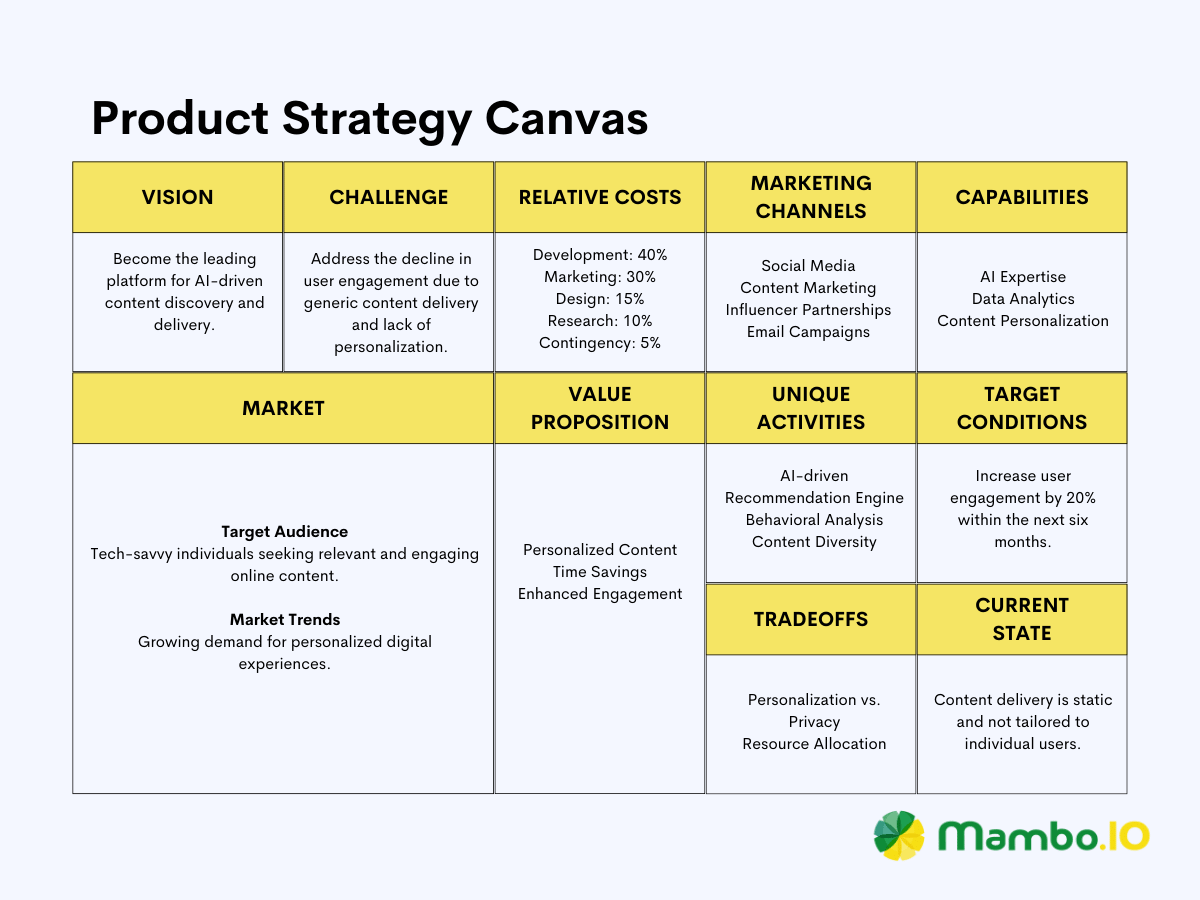
It’s crucial to understand that the product strategy and business model canvas share similarities in two different frameworks. As the name suggests, the product strategy canvas centres around an individual product. The business model canvas, on the other hand, is geared towards the broader business perspective.
When to use the Product Strategy Canvas
This tool serves as a template for devising and seeing a plan to fruition. You can employ the Product Strategy Canvas once you’ve figured out your approach to attaining your product objectives.
Decision-making frameworks
#22. DACI Framework
DACI is a decision-making framework that can clarify the roles and responsibilities present whenever important decisions are made. This framework clarifies responsibilities, streamlining decision-making and greatly reduces the ambiguity and potential conflicts amongst teams and stakeholders. Ultimately, it promotes accountability, ensuring decisions are made efficiently and with the right level of commitment from the stakeholders.
The term DACI stands for Driver, Approver, Contributor, and Informed. These are roles people involved in the product development process occupy to ensure the decisions made lead to the product’s success.

When to use the DACI framework
The DACI framework is instrumental when collaborating with cross-functional teams where complicated projects require swift and efficient completion. It can also clarify ownership when multiple stakeholders hold diverse opinions about the desired outcomes of particular initiatives.
#23. SWOT analysis
If you’re confused about whether or not to start an initiative, you can rely on the SWOT analysis for clarity.
The SWOT analysis framework offers a comprehensive view of internal and external factors affecting product success. It evaluates the Strengths, Weaknesses, Opportunities, and Threats associated with a feature or initiative. Most importantly, it’s a relatively simple tool that helps product teams decide whether a feature or initiative should be implemented.
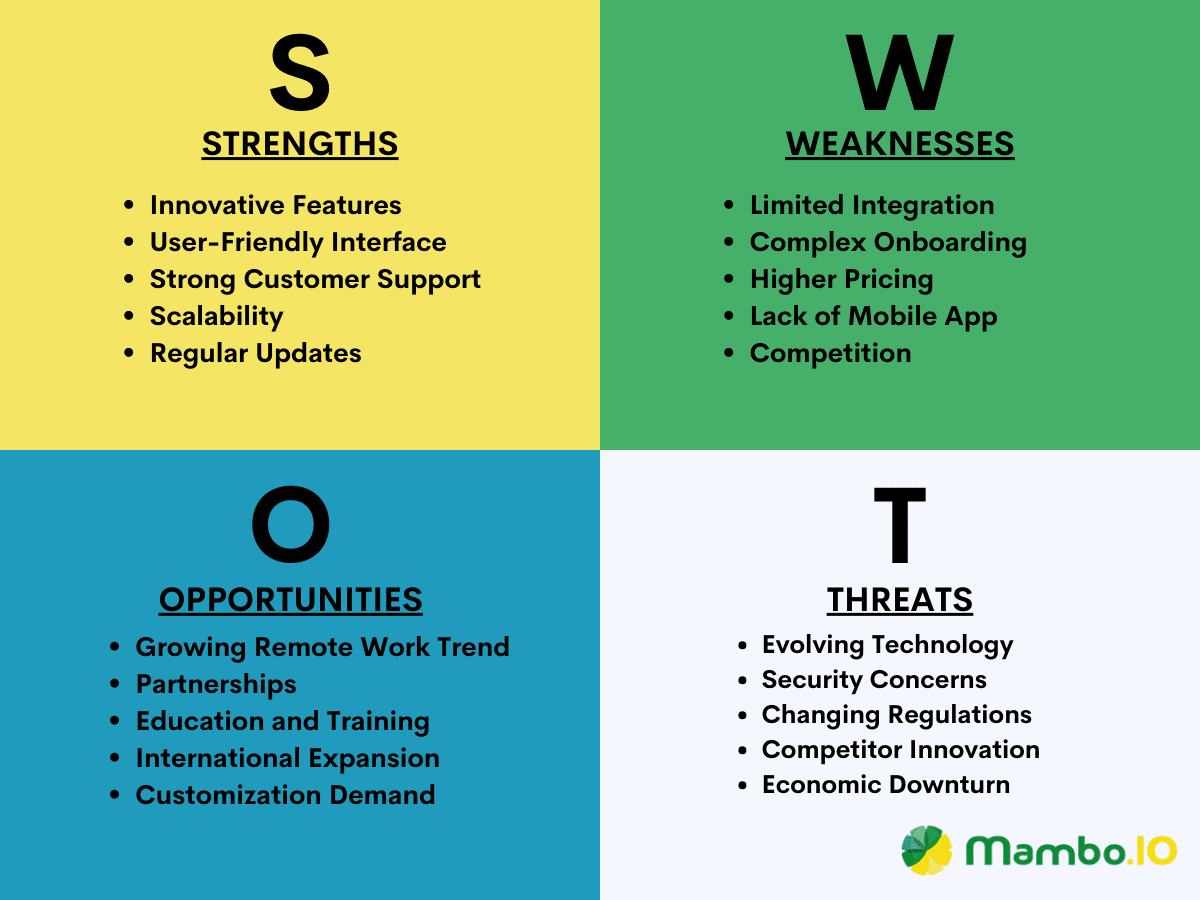
When to use SWOT analysis
SWOT analysis proves especially valuable for gaining insights into the performance of an existing product. Product managers can also use this framework to assess the viability of developing new products. Moreover, it lets product managers assess the feasibility of entering a new market.
#24. SPADE Framework
Gokul Rajam and his colleague Jeff Kolovson mastered and evolved the SPADE framework with two thoughts in mind. First, consensus doesn’t work, and second, hard decisions require sharp tools. With this in mind, the SPADE framework flourished, a decision-making framework intended to make difficult product management decisions.
The SPADE framework encompasses five elements, including:
- Setting
- People
- Alternatives
- Decide
- Explain
Ultimately, this framework can help synchronise and speed up collaboration to make difficult product management choices. Here’s an interview with Gokul Rajam, where he emphasises how the SPADE framework can help you improve your decision-making process.
When to use the SPADE framework
The SPADE framework is your go-to tool whenever your team faces challenging decisions that have real consequences for your organisation. Some notable examples of these scenarios include finalising a product plan or restructuring the product development team.
Download your free
“Gamification Guide”
Get your PDF now and start transforming your approach to digital engagement!
Latest Posts
Machine Learning In Finance: 12 Essential Applications
The impact of machine learning on finance is significant. Thanks to this technology, financial institutions are now equipped to make efficient decisions. Through the analysis of data sets, machine learning […]
How To Create Interactive Compliance Training For Bank Employees
Banking compliance training isn’t just another task. It’s the stage where everything else performs. Banks must navigate a myriad of regulations and laws. After all, this is a trust-driven, high-stakes […]
How Fintech Apps Are Using Gamification To Increase User Engagement
Discover how gamification in fintech is revolutionizing financial engagement, making banking fun & boosting user loyalty.
